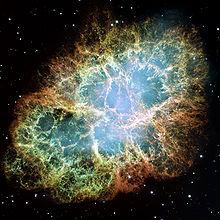| The Planck Epoch: |
The
instant of creation. It is not known how or why this
began. It can only be observed that it did begin. There is no sense in
asking what happened before, because time itself may have began at that
instant since time is a property of the universe itself. The big bang
does not describe matter
expanding to fill empty space. Space itself is what is expanding. All
of space, at this moment was extremely small (smaller than the nucleus
of an atom) and energy was distributed within it. Because the energy,
or mass (E=mc2) of the universe has been constant since this
time, the
universe was at an unimaginable energy density. This energy was in the
form of photons and exotic particles. Normal matter or even more
familiar subatomic particles could not have existed during this
scorching moment. |
| Inflation: |
Inflation
theory is a modification to the original big
bang
theory. But it is now widely accepted as part of the standard big bang
model. This theory postulates that the universe underwent a period of
rapid expansion, soon after it was born, increasing at an exponential
rate. In the first 10-32 of a second, the
universe grew by a factor of
at least 1026. It is believed that this period of
inflation is what caused the visible universe to be extremely uniform
as it would have stretched small isothermal regions far beyond the
cosmic horizon. This would also have caused the universe to be
extremely flat on scales that can be measured. All of this rapid
expansion could have made the universe too smooth for things like stars
and galaxies to form. But quantum fluctuations during
inflation would have been stretched to galactic scales. These slight
density variations would provide the seeds of galaxy formation in the
eons to come. |
| Baryogenesis: |
The
universe continues to expand at a slower rate after
inflation ends. As it expands it cools, by the same laws of
thermodynamics that exist today. The conditions at the Planck epoch and
during inflation are quite speculative, but the physics of this era are
well explored in particle accelerators of our time. Once the
temperature is low enough, protons and neutrons become stable. Neutrons
form at the rate of one for every 10 protons, resulting from the value
of the Boltzmann factor (e(mass(n)-mass(p))c2)/kT. |
| Nucleosynthesis: |
After
continued expansion, the protons and neutrons cool
(slow down) enough to form atomic nuclei (75% hydrogen, 25% helium, and
very trace amounts of Lithium and Beryllium. These are the first four
elements of the periodic table.) The proportion of these elements
predicted from theory agree closely with the observed relative
abundances of the elements in the universe. This phase begins between
100 and 300 seconds after the Planck epoch and lasts for only a few
minutes. The nuclei exist as ions, since they are too hot to combine
with electrons. Light is continually absorbed and re-emitted by the
ions, making the hot plasma opaque. |
| Decoupling: |
After
about 380,000 years the universe cools to 3000
Kelvin.
At this temperature, neutral hydrogen and helium atoms are stable. Once
neutral atoms form, light can pass through freely. This is the time
when the cosmic microwave background (CMB) was emitted. It has
continued traveling through space until this day. |
| Galaxy
Formation: |
Slightly
denser regions of gas begin to collapse under
the
pull of gravity. These gas clouds form small galaxy systems from which
the first stars form. The universe would be a few hundred million years
old before these new lights begin to form. Because only hydrogen and
helium exist, these stars were believed to be unusually massive. These
stars burned hot and fast fusing hydrogen into successively heavier
elements. A very large star will continue to fuse elements until it
reaches iron. Once the iron core reaches 1.44 solar masses, the star
will go supernova, creating all of the natural elements heavier than
iron. The blast from the supernova spreads the newly manufactured
elements into the galactic medium. These elements are then available
for the formation of future generations of stars and planets. |
| Coalescence: |
Many
generations of stars are born and die. Further
enriching
the universe with heavy elements. Since the beginning until now, stars
have converted about 2% of the universe’s hydrogen into other
elements. Small galaxies coalesce into larger galaxies. Groups of
galaxies are drawn together by gravity to form clusters and
super-clusters of galaxies (thousands or millions of galaxies). All the
while the universe is still expanding, so these massive clusters are
getting farther away from each other. This process continues today
(13.8 billion years after the Planck epoch). |




